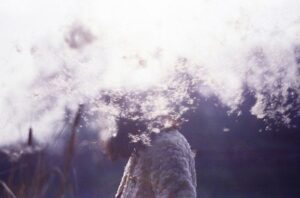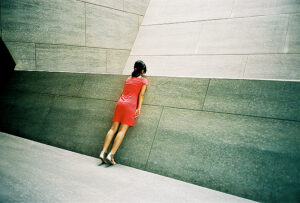
Alena: Freedom from Everything (2022) is a personal essay film about twin pandemics – COVID and AIDS. You frame the reaction shots to these global reactions in an examination of neo-liberalism, even returning us, for a moment, to the origins of capitalism itself. Why did you want to make this film? How did you get started?
Mike: My mother died at the beginning of the pandemic, suddenly and unexpectedly. My sister found her lying unresponsive, and we rushed to the hospital where she spent her last hours in a coma, undoing her knots, her ties to the world. After hours of funereal silence she broke out into a forbidden song from the other side and then it was over.
When his second marriage ended in exile my friend Mike pronounced himself shipwrecked, “without the star that ought to guide one.” A line he repeated like prayer. I felt unmoored from my old bodies, the fortresses of the self I had built to keep everyday conversations from drowning me in someone else’s urgency.
I want to say “I remember an image” but it would be more accurate to say that I was remembered by an image, summoned by a picture. It came from an essay by the genius artist/writer Hito Steyerl called Freedom from Everything: Freelancers and Mercenaries (2013) (https://www.e-flux.com/journal/41/60229/freedom-from-everything-freelancers-and-mercenaries/). It begins with the Berlin Wall falling, and the various pop song odes to “freedom” that arrived at the same moment, and then swings into a discussion of the origins of the freelancer, a medieval mercenary who rents out his “free lance.” Rippling beneath it all is a body that is free falling, lighter than air, “free” from a steady job, living in a good neighbourhood, decent health care, in her phrase: free from everything. This image of a new economic precarity, of a body forever falling in a spaceless space, was also my body. That’s where the movie began, and it remains, at least for me, the central image of the movie.
Alena: The word pandemic, as you point out in the film, is from the Latin pandemos, meaning “affecting all the people.” How did you create an opening, an aperture, from which you could make pictures that might touch all the people?
Mike: It was never one pandemic but many. Everyone I spoke to was locked away in their apartment universe or else hopping on flights chasing new dreams. We were burying our parents or looking after them, as they wandered between worlds. How to find a picture that could hold the new trials and old joys of this period? For me it meant returning to my oldest companion, fear, and how it turns too often to show its other face: anger. When I am in my fear body I am very small, even the kindest face can appear threatening and oversized, as if it belonged to an angry giant. Fear is the inhale, anger is the exhale, it expands the body, you see this with cats who are afraid/angry, they turn sideways to show that they are large, and not to be messed with. This alternating current of fear and angry is one of the movie’s recurring themes, learned from my mother, it reappears in public forums like the weekly freedom rallies.
Alena: The question of freedom haunts your movie, can you talk about what freedom means, or how it functions in your movie?
Mike: In her essay, Hito offers a newly updated idea of “negative freedom.” We are accustomed to regarding freedom as primarily positive—the freedom to do or have something; thus there is the freedom of speech, the freedom to pursue happiness and opportunity, or the freedom of worship. But now the situation is shifting. Especially in the current economic and political crisis, the flipside of liberal ideas of freedom—namely, the freedom of corporations from any form of regulation, as well as the freedom to relentlessly pursue one’s own interest at the expense of everyone else’s—has become the only form of universal freedom that exists: the freedom from social bonds, freedom from solidarity, freedom from certainty or predictability, freedom from employment or labor, freedom from culture, public transport, education, or anything public at all.
Perhaps it’s not a surprise that some of the main voices of COVID misinformation came from the wellness industry (the Center for Countering Digital Hate counted a dozen people responsible for more than half the anti-vaccine content on Facebook and Twitter), where the neoliberal idea that “there is no such thing as society,” that we are all alone, mythic creators of our own worlds, means that with enough hard work you can conquer every illness, have a perfect body, abandon doctors to pursue your own “wellness journey.” And on the flip side, if you’re sick or poor, it’s your fault. Personal freedom on the yoga mat blends with neoliberalism’s ruling class demands.

Alena: You use a lot of found footage in this movie. Do you have a large archive out of which you’re drawing material, or do you collect clips for every project?
Mike: I have two main practices: reading and listening. I have an extensive archive of sounds, and some of these are used in the movie. I like listening to wind rustling through dry leaves, or the symphony of lawn mowers in a public park, or bottles rattling in a cart. I record my own sounds with a very small pair of clip-on stereo mics, and buy a lot of sounds from dealers and small companies. A few years ago I donated a large part of my collection to the local film co-op.
I collect images for each project. The movie tries to find the roots of neoliberalism by returning to the origins of capitalism in the 14th century. There are two primary events: the first is a two-century long attack on women that was called the witch hunt. The second is a theft of “the commons,” which at that time was land, forests, or lakes that didn’t belong to anyone, that even peasants could use. This land was fenced off, or enclosed, and privatized – what once belonged to everyone now belonged to individuals who became rich beyond imagination. These enclosures have never stopped happening, today for example our drinking water, our geographical locations, our computer clicks, our “likes and dislikes” are stolen and monetized by a new ruling class.
The images that I use are part of “the commons.” For those who believe, like I do, that copyright is primarily an instrument of corporations to maximize profit, there is a “creative commons” license that allows the free distribution and re-use of materials. My work, like many others, lives on the internet with a download button that allows viewers to take it and do with it whatever they choose. Buddhists might name this practice “interdependence,” a recognition that we are all parts of each other, because as the old Communist slogan goes, “property is theft.”
Alena: You compare the COVID pandemic with the AIDS pandemic that you were personally touched by. Can you talk about why you return to the American artist David Wojnarowicz, who figures so prominently in your film?
Mike: For socially anxious people like me, books can become your best friend. One of the most important for me, after becoming positive at a moment when there was no medication to treat it, was a book by David Wojnarowicz (voy-na-roe-vitch) called Close to the Knives: A Memoir of Disintegration. (1991). Everything he described felt familiar, as if we were living in the same body, even though we had led completely different lives.
…even a tiny charcoal scratching done as a gesture to mark a person’s response to this epidemic means whole worlds to me if it is hung in public; bottom line, each and every gesture carries a reverberation that is meaningful in its diversity; bottom line, we have to find our own forms of gesture and communication. You can never depend on the mass media to reflect us or our needs or our states of mind; bottom line, with enough gestures we can deafen the satellites and lift the curtains surrounding the control room.
He speaks explicitly in the movie about the alternating current of fear and anger, about what it means to make pictures of the dying, and how it feels to be sick in a diseased society.
Alena: During the pandemic there was a pervasive feeling of waiting, that we were holding on until some new state would arrive. It was as if the future had been delayed so that a necessary change would come. Did you also experience this feeling of waiting?
Mike: In 1914 Franz Kafka wrote a novel called The Trial. The next year he sliced out a very small piece of it and turned it into a celebrated short story called Before the Law. A man from the country makes a long trek, hoping to enter the law. The door is open, but in front of it is an imposing gatekeeper, who tells him that while he can’t enter yet, it might be possible later. The gatekeeper offers him a stool where the man sits for days, weeks, years. He asks over and again but always receives the same answer. He gives the gatekeeper gifts that prompt him to reply, “I am taking this only so that you do not think you have tried to do everything.” At the end of his life, the old man stammers out a question that has been haunting him all these years. “Everyone strives after the law,” says the man, “so how is that in these many years no one except me has requested entry?” Because the man’s hearing is so bad, the gatekeeper has to shout to him. “Here no one else can gain entry, since this entrance was assigned only to you. I’m going now to close it.”